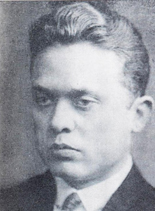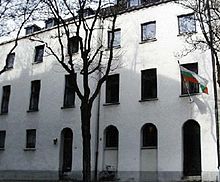Kuno Kamphausen
Conrad ( Kuno ) Carl Adolph Kamphausen (born November 27, 1900 in Krefeld , † June 30, 1934 in Waldenburg (Silesia) ) was a German architect and construction clerk , martyr of the Catholic Church .
Life
After graduating from high school, Kamphausen studied architecture at the Technical University of Darmstadt . During his studies he belonged to the KDSt.V. Nassovia Darmstadt in the CV . For his doctorate , he moved to the Technical University of Aachen in 1926 , where he joined the KDSt.V. Bergland (Freiberg) Aachen joined in CV, whose house he planned in 1931/1932. From 1926 to December 1932 he was a member of the Center Party ; there he did not step forward.
In 1932 Kamphausen was elected to the town planning authority of the Silesian town of Waldenburg. He was inducted into office on February 15, 1933, and held it until his death in 1934.
Assassination by SS men
On June 30, 1934, SS units in particular began a wave of political cleansing in the National Socialist movement known as the Röhm Putsch . This was directed primarily against men in the SA leadership around Ernst Röhm and also against other "public enemies".
Kamphausen had refused a brother of the SS-Standartenführer Förster a building permit. Forester and a standard leader named Deponte wanted to use the opportunity that seemed favorable to them to “settle personal bills” or to murder unwelcome people.
Förster and Deponte had also put the mayor of Waldenburg, Daniels, the slaughterhouse director Grosse and the tax office director Schmidt on their personal death list. These three survived because they were not at home on the evening of June 30, 1934 and were therefore not found by the SS men who were assigned to them.
Kamphausen was fetched from his apartment by SS men around 10.30 p.m. on the pretext that he should be brought before the NSDAP district leader . He was taken away in a car and shot by SS man Erich Sstaak . The next morning around 8 a.m., his body was found by a miner in the ditch on the Neu-Kraussendorf road to Reussendorf near Reussendorf. During the autopsy in the Knappschaftslazarett in Waldenburg, eleven bullet holes were found.
His name was not on the list of 77 people killed between June 30 and July 2, 1934, whose death the Reich Government had declared legal by means of the State Emergency Defense Act of July 3, 1934 and thus withdrawn from investigation by the law enforcement authorities.
The police, alerted by Kamphausen's wife, refused to intervene with the words: "On that night when the SS seized power, the police cannot do anything" .
Trial of those involved in the murder
The then Reich Justice Minister Franz Gürtner soon found out about the murders of six not on the list; he traveled with Freisler and Joël to Goering, who was inclined to condemn the perpetrators. Heinrich Himmler was against it; Hitler hesitated.
Proceedings against eight accused of murder , deprivation of liberty and presumption of office were opened before the jury court in Wroclaw . The trial did not take place in public and without the relatives of Kamphausen.
On September 26, 1934, the court sentenced the SS-Rottenführer to five years in prison (for manslaughter in unity with official presumption and serious deprivation of liberty) and the involved SS-Oberscharführer to two years.
The three convicts were all released within a year. Five people involved were acquitted, including Sstaak. He was granted an innocent error about the existence of a state emergency , as the court believed that he had carried out the order of his superiors to shoot Kamphausen in the belief that it was legal. Specifically, based on the information from his superiors, he had reason to believe that Kamphausen had supported the alleged SA revolt and that his killing was therefore necessary for reasons of the state's self-protection.
burial
Kamphausen's body was later transferred to Lorsch and buried there.
Appreciations
In 2010, the Catholic Church accepted Kuno Kamphausen as a witness of faith in the German martyrology of the 20th century .
Archival material
The documents relating to the internal SS investigation into the murder of Kamphausen have been preserved in Erich Makosch's SS personnel file ; this file is now stored in the Berlin Document Center (BDC: SSO file Erich Makosch).
literature
- Helmut Moll (Ed. On behalf of the German Bishops' Conference): Witnesses for Christ. The German Martyrology of the 20th Century , Paderborn a. a. 1999, 7th revised and updated edition 2019, ISBN 978-3-506-78012-6 , Volume I, pp. 55–59.
- Ders .: The new home. Krefeld yearbook. November 2004.
- Academia. Journal of the Cartell Association. 1/2001, p. 50f.
- Academia. Journal of the Cartell Association. 2/2005, p. 97.
Footnotes
- ↑ Lothar Gruchmann : Justice in the Third Reich 1933-1940: Adaptation and submission in the Gürtner era , p. 462ff. (Oldenbourg Wissenschaftsverlag, 2002, ISBN 978-3486538335 )
- ↑ Gruchmann: Justice in the Third Reich. P. 467.
| personal data | |
|---|---|
| SURNAME | Kamphausen, Kuno |
| ALTERNATIVE NAMES | Kamphausen, Conrad Carl Adolph |
| BRIEF DESCRIPTION | German architect and Nazi victim |
| DATE OF BIRTH | November 27, 1900 |
| PLACE OF BIRTH | Krefeld |
| DATE OF DEATH | June 30, 1934 |
| Place of death | Waldenburg (Silesia) |

